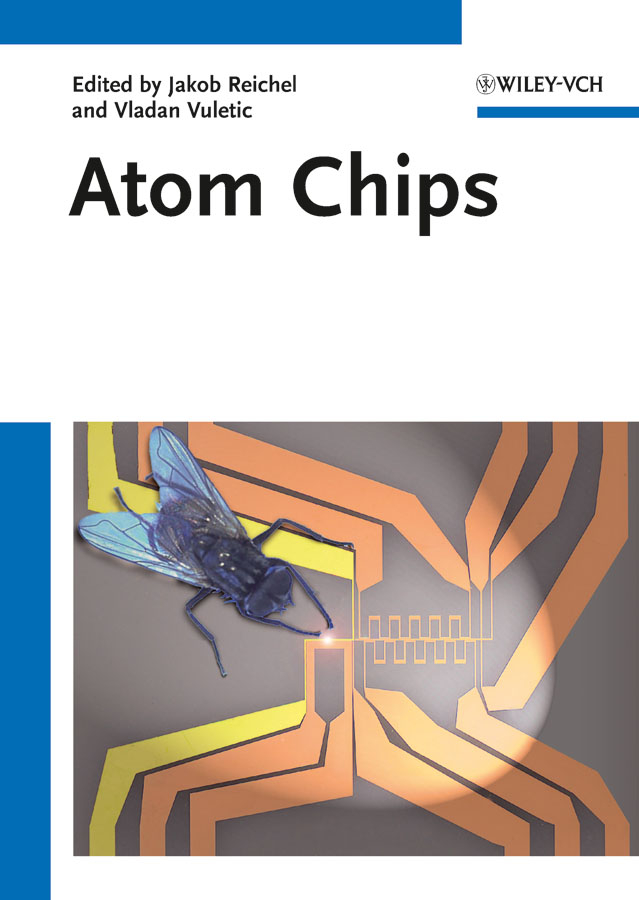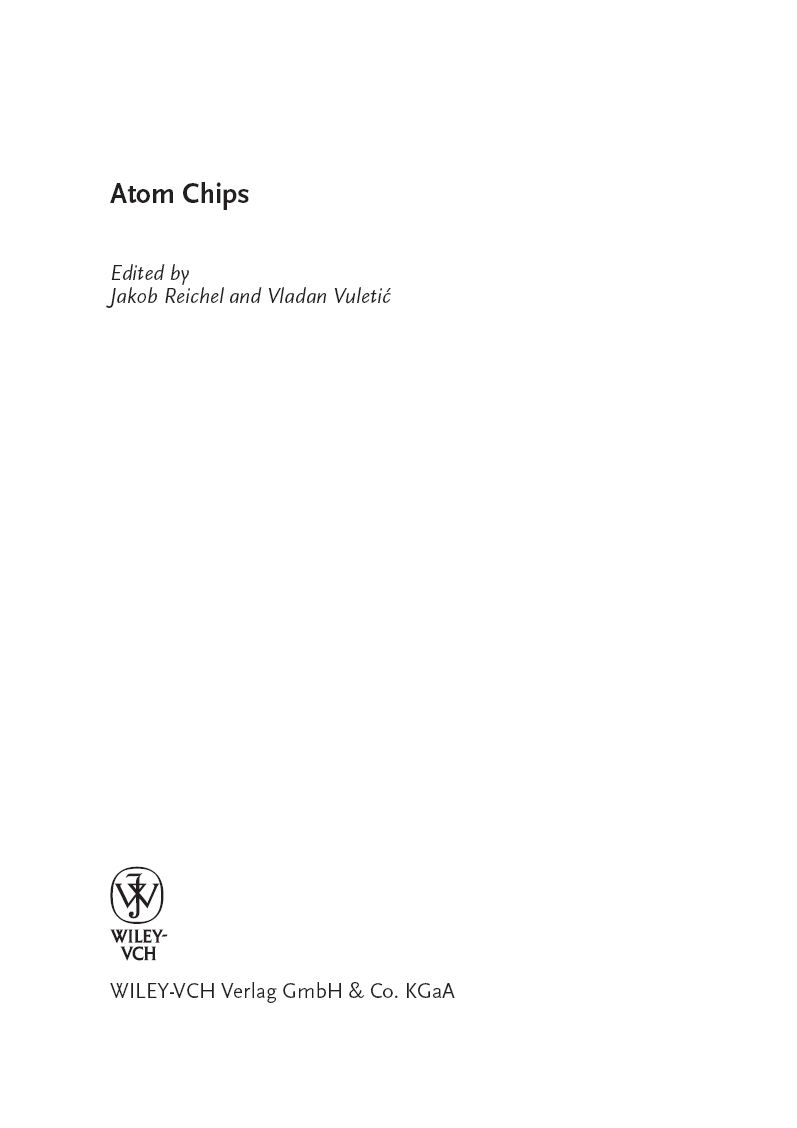


Contents
ANDREI SIDOROV AND PETER HANNAFORD
JAKOB REICHEL
RON FOLMAN, PHILIPP TREUTLEIN AND JÖRG SCHMIEDMAYER
STEFAN SCHEEL AND E.A. HINDS
CARSTEN HENKEL
A. GÜNTHER, T.E. JUDD, J. FORTÁGH AND C. ZIMMERMANN
THORSTEN SCHUMM, STEPHANIE MANZ, ROBERT BÜCKER, DAVID A. SMITH AND JÖRG SCHMIEDMAYER
VLADAN VULETIĆ, IAN D. LEROUX AND MONIKA H. SCHLEIER-SMITH
PHILIPP TREUTLEIN, ANTONIO NEGRETTI AND TOMMASO CALARCO
GILLES NOGUES, ADRIAN LUPAŞCU, ANDREAS EMMERT, MICHEL BRUNE, JEAN-MICHEL RAIMOND AND SERGE HAROCHE
I. BOUCHOULE, N.J. VAN DRUTEN AND C.I. WESTBROOK
MARCIUS H.T. EXTAVOUR, LINDSAY J. LEBLANC, JASON MCKEEVER, ALMA B. BARDON, SETH AUBIN, STEFAN MYRSKOG, THORSTEN SCHUMM AND JOSEPH H. THYWISSEN
J.M. AMINI, J. BRITTON, D. LEIBFRIED AND D.J. WINELAND
Related Titles
Stolze, J., Suter, D.
Quantum Computing
A Short Course from Theory to Experiment
2008
ISBN: 978-3-527-40787-3
Matta, C.F., Boyd, R.J. (eds.)
The Quantum Theory of Atoms in Molecules
From Solid State to DNA and Drug Design
2007
ISBN: 978-3-527-30748-7
Bruß, D., Leuchs, G. (eds.)
Lectures on Quantum Information
2007
ISBN: 978-3-527-40527-5
Vogel, W., Welsch, D.-G.
Quantum Optics
2006
ISBN: 978-3-527-40507-7
Bachor,H.-A., Ralph,T.C.
A Guide to Experiments in Quantum Optics
2004
ISBN: 978-3-527-40393-6
Weidemüller, M., Zimmermann, C. (eds.)
Interactions in Ultracold Gases
From Atoms to Molecules
2009
ISBN: 978-3-527-40750-7
Leuchs, G., Beth,T.(eds.)
Quantum Information Processing
2003
ISBN: 978-3-527-40371-4
Cohen-Tannoudji, C., Dupont-Roc, J., Grynberg, G.
Atom-Photon Interactions
Basic Processes and Applications
1998
ISBN: 978-0-471-29336-1

The Editors
Prof. Jakob Reiche
Laboratoire Kastler Brossel de l’E.N.S. 24, rue Lhomond 75231 Paris Cedex 05 Frankreich
Prof. Vladan Vuleti
Massachusetts Inst. of Technology, Room 26-231 77, Massachusetts Avenue Cambridge, MA 02139-4309 USA
All books published by Wiley-VCH are carefully produced. Nevertheless, authors, editors, and publisher do not warrant the information contained in these books, including this book, to be free of errors. Readers are advised to keep in mind that statements, data, illustrations, procedural details or other items may inadvertently be inaccurate.
Library of Congress Card No.: applied for
British Library Cataloguing-in-Publication Data: A catalogue record for this book is available from the British Library.
Bibliographic information published by the Deutsche Nationalbibliothek The Deutsche Nationalbibliothek lists this publication in the Deutsche Nationalbibliografie; detailed bibliographic data are available on the Internet at .
© 2011 WILEY-VCH Verlag GmbH & Co. KGaA, Boschstr. 12, 69469 Weinheim, Germany
All rights reserved (including those of translation into other languages). No part of this book may be reproduced in any form – by photoprinting, microfilm, or any other means – nor transmitted or translated into a machine language without written permission from the publishers. Registered names, trademarks, etc. used in this book, even when not specifically marked as such, are not to be considered unprotected by law.
Preface
This book intends to give both an introduction and an in-depth review of the beautiful physics being done with atom chips. Topics range from the manipulation of single atoms to the quantum entanglement between many atoms, and from interferometry with atomic matter waves to studies of fundamental atom–surface interactions.
For about three decades researchers have used magnetic and electric fields from DC to optical frequencies to confine neutral atoms for a variety of experiments and applications. The term atom chip has come to designate setups where microscopic or micro-fabricated structures, typically confined to a surface, generate three-dimensional trapping fields in the vicinity of the surface.
At its inception, the atom chip was regarded primarily as a tool to conveniently generate electromagnetic fields varying on a small length scale, and as such is related to early prototypes of magnetic mirrors. In fact, the attainment of Bose–Einstein condensation on a chip in 2001 in Tübingen and Munich was the first landmark that brought atom chips to the attention of the physics community at large. Since then, a growing number of research groups has adopted microchips as a convenient and fast method for the creation of Bose–Einstein condensates (BECs), and now also degenerate Fermi gases.
The strongly confining, complex, multi-parameter potentials that can be realized with atom chips have enabled experimentalists to explore new situations. For example, studies of one-dimensional quantum gases are benefitting from extremely elongated single traps that can be generated on atom chips, and BECs have been diffracted from specifically designed magnetic lattices realized on the chip surface.
However, atom chips are not merely devices to form atom traps by a combination of conductors and insulators on a surface. Atom chips promise rich functionality and integrability, and possibly nano-scale miniaturization, as advertised early on by a number of researchers in the field. The small length scale well matched to the condensate size and proximity of a solid surface have opened up and driven further research possibilities. The first and perhaps most immediate example is the investigation of fundamental surface-induced forces, such as the van der Waals and Casimir–Polder forces. This field has progressed and expanded considerably due to the close and stimulating interaction between atom chip experimentalists and theorists. Furthermore, the repertoire of fields and interactions used on atom chips has grown to include radiofrequency and microwave potentials, resonant and fardetuned optical fields in miniature optical devices, as well as surface interactions with micro-mechanical structures. In each case, the small-scale, near-field situation of the atom chip has been exploited in ingenious ways to create new and rich physical situations that go beyond the possibilities of macroscopic experiments. Examples include coupling of a BEC to an oscillating mechanical cantilever, cavity quantum electrodynamics experiments with BECs, and some of the most beautiful condensate interferometry experiments performed so far.
The combination of these features makes atom chips an interesting platform for quantum information and quantum simulation experiments. This has also motivated the development of the newest family of atom chips, surface-electrode-based ion traps, which present both similarities and interesting differences compared to their neutral-atom counterparts.
A third area has emerged where atom chips are used as a means to construct the most compact and robust ultra-cold atom devices. The very recent demonstration of BEC in microgravity was enabled by an atom chip. Trapped-atom clocks on atom chips are being explored as promising secondary frequency standards. The idea of “integrated atom optics” on atom chips as a means to build atom interferometers emerged with the first atom chip experiments, but is certainly still in its infancy today. Last but not least, experiments with BECs in cryogenic environments also benefit from the small size and robustness of atom chips.
This book represents a collective effort by the community of atom chip researchers to outline the state of their knowledge as of 2009/2010. Each chapter starts with a thorough introduction before exposing the state of the art on a specific topic. Additionally, there are introductory chapters describing the particularities of designing magnetic potentials and producing BECs on atom chips, as well as on atom chip fabrication. The latter is discussed in a tutorial style and sufficient detail to enable a researcher with minimal micro-fabrication knowledge to start fabricating atom chips. In this way, we hope that the book will be valuable for students and researchers who are entering the field of atom chips or are active in one of the neighboring fields, but also for anyone desiring to get an overview of this beautiful and active area of contemporary quantum physics.
Paris and Cambridge, June 2010
Jakob Reichel and Vladan Vuletić
List of Contributors
Jason M. Amini
Signature Technology Laboratory Georgia Technology Research Institute 400 Tenth Street Atlanta, GA 30318 USA
Seth Aubin
Department of Physics College of William and Mary Williamsburg, VA 23185 USA
Alma B. Bardon
Department of Physics University of Toronto 60 St. George Street Toronto, Ontario M5S 1A7 Canada
Isabelle Bouchoule
Laboratoire Charles Fabry de l’Institut d’Optique Campus Polytechnique RD 128 91127 Palaiseau Cedex France
Joe Britton
Time and Frequency Division National Institute of Standards and Technology 325 Broadway Boulder, CO 80305 USA
Michel Brune
Laboratoire Kastler Brossel de l’E.N.S. 24, rue Lhomond 75231 Paris Cedex 05 France
Robert Bücker
Atominstitut der Österreichischen Universitäten TU Wien Stadionallee 2 1020 Wien Austria
Tommaso Calarco
Institut für Quanteninformationsverarbeitung Universität Ulm Albert-Einstein-Allee 11 89069 Ulm Germany
Andreas Emmert
Laboratoire Kastler Brossel de l’E.N.S. 24, rue Lhomond 75231 Paris Cedex 05 France
Marcius H.T.Extavour
Ontario Power Generation 700 University Avenue Toronto, Ontario Canada, M5G 1X6
Ron Folman
Atom Chip Group Ben-Gurion University Be’er Sheva, 84105 Israel
József Fortágh
Physikalisches Institut Universität Tübingen Auf der Morgenstelle 14 72076 Tübingen Germany
A. Günther
Physikalisches Institut Universität Tübingen Auf der Morgenstelle 14 72076 Tübingen Germany
Peter Hannaford
Centre for Atom Optics & Ultrafast Spectroscopy Faculty of Engineering and Industrial Science Swinburne University of Technology Serpells Lane, Mail H38, PO Box 218 Hawthorn, Victoria 3122 Australia
Serge Haroche
Laboratoire Kastler Brossel de l’E.N.S. 24, rue Lhomond 75231 Paris Cedex 05 France
Carsten Henkel
Institut für Physik und Astronomie Campus Golm Universität Potsdam 14476 Potsdam Germany
Edward A. Hinds
Centre for Cold Matter Blackett Laboratory Imperial College London Prince Consort Road London SW7 2AZ United Kingdom
Thomas E. Judd
Physikalisches Institut Universität Tübingen Auf der Morgenstelle 14 72076 Tübingen Germany
Lindsay J. LeBlanc
Department of Physics University of Toronto 60 St. George Street Toronto, Ontario M5S 1A7 Canada
Dietrich Leibfried
Time and Frequency Division National Institute of Standards and Technology 325 Broadway Boulder, CO 80305 USA
Ian D. Leroux
MIT Department of Physics 77 Massachusetts Avenue Cambridge, MA 02139 USA
Adrian Lupaşcu
Institute for Quantum Computing University of Waterloo 200 University Ave. W. Waterloo, ON N2L 3G1 Canada
Stephanie Manz
Atominstitut der Österreichischen Universitäten TU Wien Stadionallee 2 1020 Wien Austria
Jason McKeever
Entanglement Technologies Palo Alto, CA 94306 USA
Stefan Myrskog
Morgan Solar Inc. 30 Ordnance St. Toronto, Ontario M6K 1A2 Canada
Antonio Negretti
Institut für Quanteninformationsverarbeitung Universität Ulm Albert-Einstein-Allee 11 89069 Ulm Germany
Gilles Nogues
Institut Neel 25 avenue des Martyrs bâtiment T, BP 166 38042 Grenoble cedex 9
Jean-Michel Raimond
Laboratoire Kastler Brossel de l’E.N.S. 24, rue Lhomond 75231 Paris Cedex 05 France
Jakob Reichel
Laboratoire Kastler Brossel de l’E.N.S. 24, rue Lhomond 75231 Paris Cedex 05 France
Stefan Scheel
Blackett Laboratory Imperial College London Prince Consort Road London SW7 2AZ United Kingdom
Monika H. Schleier-Smith
MIT Department of Physics 77 Massachusetts Avenue Cambridge, MA 02139 USA
Jörg Schmiedmayer
Atominstitut der Oesterreichischen Universitäten TU Wien Stadionallee 2 1020 Vienna Austria
Thorsten Schumm
Atominstitut der Österreichischen Universitäten TU Wien Stadionallee 2 1020 Wien Austria
Andrei Sidorov
Centre for Atom Optics & Ultrafast Spectroscopy Faculty of Engineering and Industrial Science Swinburne University of Technology Serpells Lane, Mail H38, PO Box 218 Hawthorn, Victoria 3122 Australia
David A. Smith
Atominstitut der Österreichischen Universitäten TU Wien Stadionallee 2 1020 Wien Austria
Joseph H. Thywissen
Department of Physics University of Toronto 60 St. George Street Toronto, Ontario M5S 1A7 Canada
Philipp Treutlein
University of Basel Department of Physics Klingelbergstrasse 82 CH-4056 Basel Switzerland
N. J. (Klaasjan) van Druten
Van der Waals-Zeeman Instituut Universiteit van Amsterdam Valckenierstraat 65-67 1018 XE Amsterdam Netherlands
Vladan Vuletić
MIT Department of Physics 77 Massachusetts Avenue Cambridge, MA 02139 USA
Christopher I. Westbrook
Laboratoire Charles Fabry de l’Institut d’Optique Campus Polytechnique RD 128 91127 Palaiseau Cedex France
David J. Wineland
Time and Frequency Division National Institute of Standards and Technology 325 Broadway Boulder, CO 80305 USA
C. Zimmermann
Physikalisches Institut Universität Tübingen Auf der Morgenstelle 14 72076 Tübingen Germany
PART ONE
FUNDAMENTALS